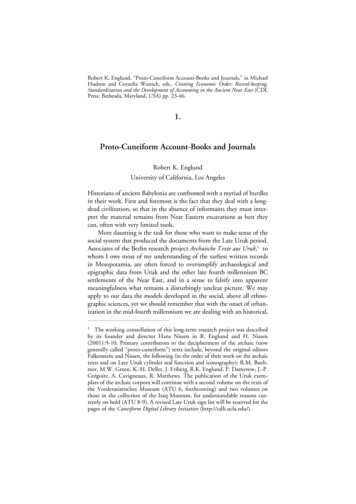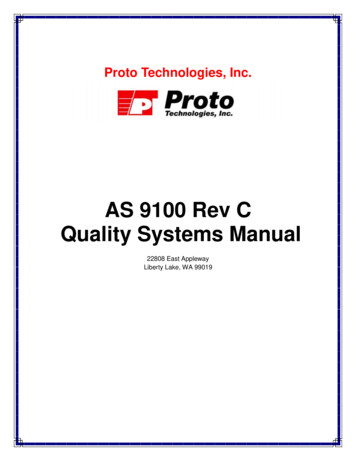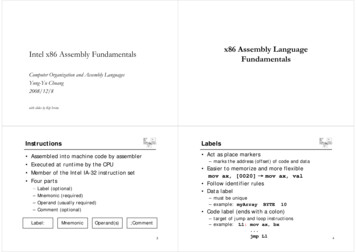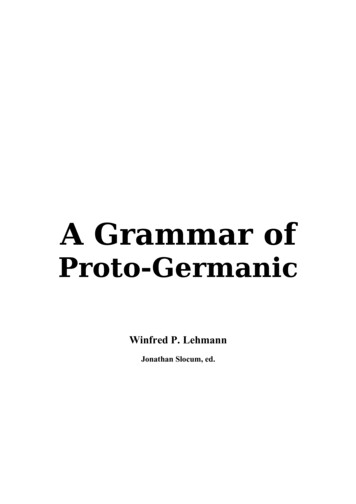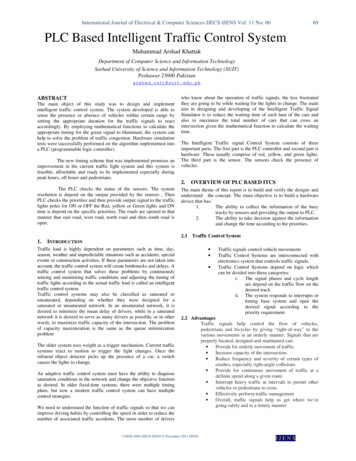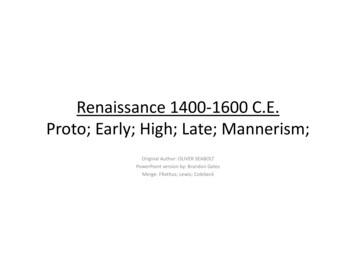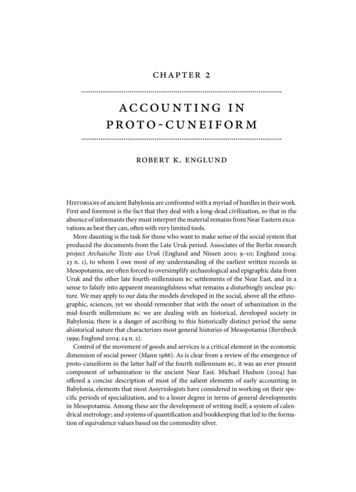
Transcription
chapter 2accou n ti ng i nproto - cu n eifor mrobert k. englundHistorians of ancient Babylonia are confronted with a myriad of hurdles in their work.First and foremost is the fact that they deal with a long-dead civilization, so that in theabsence of informants they must interpret the material remains from Near Eastern excavations as best they can, often with very limited tools.More daunting is the task for those who want to make sense of the social system thatproduced the documents from the Late Uruk period. Associates of the Berlin researchproject Archaische Texte aus Uruk (Englund and Nissen 2001: 9–10; Englund 2004:23 n. 1), to whom I owe most of my understanding of the earliest written records inMesopotamia, are often forced to oversimplify archaeological and epigraphic data fromUruk and the other late fourth-millennium bc settlements of the Near East, and in asense to falsify into apparent meaningfulness what remains a disturbingly unclear picture. We may apply to our data the models developed in the social, above all the ethnographic, sciences, yet we should remember that with the onset of urbanization in themid-fourth millennium bc we are dealing with an historical, developed society inBabylonia; there is a danger of ascribing to this historically distinct period the sameahistorical nature that characterizes most general histories of Mesopotamia (Bernbeck1999; Englund 2004: 24 n. 2).Control of the movement of goods and services is a critical element in the economicdimension of social power (Mann 1986). As is clear from a review of the emergence ofproto-cuneiform in the latter half of the fourth millennium bc, it was an ever presentcomponent of urbanization in the ancient Near East. Michael Hudson (2004) hasoffered a concise description of most of the salient elements of early accounting inBabylonia, elements that most Assyriologists have considered in working on their specific periods of specialization, and to a lesser degree in terms of general developmentsin Mesopotamia. Among these are the development of writing itself; a system of calendrical metrology; and systems of quantification and bookkeeping that led to the formation of equivalence values based on the commodity silver.
accounting in proto-cuneiform Considering the importance of precious metals in most early civilizations, it mightseem surprising to learn that we have no clear evidence in the archaic texts of the use ofweights, nor any evidence that silver was in any way used in early households in a manner comparable to later, third-millennium usage. We indeed are hard pressed to cite evidence for the utilization of equivalence values in the Late Uruk period, with the possibleexception of ration days.An attempt is made in the following pages to give a general impression of the little weknow about the accounting methods in the archaic period, with occasionally formalisticinformation culled from early texts, starting with a review of the development of writing; discussing in short fashion the importance of archaic numerical and metrologicalsystems as elements of social control; illuminating the use of writing with some examples drawn from grain administration archives; touching on the matter of labour management; and closing with a tentative discussion of the implications the labour accountshave for our understanding of archaic ideology of class.Account-keeping and the emergenceof writingMore so than other writing systems, cuneiform has been described as a script based on along history of preliterate accounting devices. Most who have studied the matter haveconsidered early writing to be a collateral development from the exploitation of anincreasingly complex method of fixing quantitative data.Urbanization in southern Babylonia during the Middle and Late Uruk periodsresulted in the growth of the settlement of southern Mesopotamian Uruk into anexpanse of 200 hectares, with a population estimated to have approached 40,000 ormore. Very large numbers of this population evidently were available for the construction and maintenance of the massive public district known as Eanna, with its monumental architecture surely the clearest testimony to the extraordinary new surpluseconomy supporting Uruk.Hand in hand with these urban developments (Figure 2.1) are found in the archaeological record a series of accounting devices known popularly as ‘tokens’ since the publications of Denise Schmandt-Besserat (1992; 1996). While the archaeologist has beenfaulted for over-interpreting both the systematization and the iconic differentiation ofthese small clay objects (Englund 2004: 26 n. 4), there can be little doubt that at least asubset consisting of many of her simple geometrical artefacts represents the precursorsof writing in Mesopotamia, and therefore that cuneiform began with numerical signs.This assertion is based on two phenomena (Figure 2.2). First, the simple tokens weregathered in discrete assemblages and encased in clay balls in the periods immediatelybefore the emergence of proto-cuneiform c. 3300 bc, and these balls were then sealedwith impressions from cylinder seals—the hallmark of 3000 years of Babylonian
robert k. englundPeriodLate Uruk3200Archaic texts from Uruk:writing Phase Uruk IV,writing Phase Uruk III31003000Historical DevelopmentsClay bullae andnumerical tablets34003300Writing PhaseBeginning of large-scalesettlement of BabyloniaFirst urban centresAge of early civilizationJemdet Nasr2900Early Dynastic I280027002400Formation of largeirrigation networksEarly Dynastic II26002500Archaic texts from UrTexts from FaraEarly Dynastic IIIRival city-statesOld Sumerian textsfigure 2.1 Overview of the chronology and historical developments of the earliest literate periods in Babylonia.administrative history. Second, the plastic tokens were themselves impressed on theouter surfaces of some balls, leaving marks which, both physically and also in their context, conform exactly to the impressed numerical signs of the early so-called numericaltablets and the curvilinear tradition of Babylonian accounts down to the Ur III period atthe end of the third millennium. We have little doubt that a statistical analysis of theoverwhelming numbers of tokens still encased within clay envelopes would lead evenfurther, to the establishment of the preliterate use of numerical sign systems with thesame abstraction of unit bundling as has been shown for proto-cuneiform numericalnotations. We should anticipate that we will find the two most important numerical systems in these tokens, one used to count discrete objects and one used to quantify capacity measures (Englund 2006).It is of historical interest that the so-called Uruk expansion continued down throughthe use of bullae and sealed numerical tablets. Further, as Reinhard Dittmann (1986:332–366) demonstrated, this contact continued into the earliest phase of ‘ideographic’inscriptions of the Late Uruk period, those that I have called the numero-ideographictablets (Englund 1998: 51–56). These texts from the Susa level 17Ax ‘contact’ (Damerowand Englund 1989: 15 n. 37; Englund 2004: 27 n. 6) correspond nicely with texts found inthe area of the Red Temple at Uruk, characterized by their inclusion of seal impressions,numerical notations, and one or at most two apparent ideograms representing the basicagricultural commodities butter oil, textiles, and small cattle.At this point there is an abrupt conclusion of interregional Uruk influence, with acontinuation of development of writing in Uruk alone (Englund 2004: 28 n. 7). The
accounting in proto-cuneiform 8500 B.C.3500 B.C.3300 B.C.3000 ideographictabletsfigure 2.2 Denise Schmandt-Besserat’s schema of the history of writing. (Based on SchmandtBesserat 1992; 1996)archives from Uruk consist above all of administrative documents, accompanied by agroup of texts generally known as lexical lists, although there is good reason to assertthat we have among these lists the earliest known example of literature (Englund andNissen 1993: 25–29). It should be remembered that the numbers generally cited in thisconnection, 85 administrative and 15 lexical texts, represent averages; less than 1 ofthe earliest, the Uruk IV tablets, are of the lexical genre, while close to 20 of the following Uruk III tablets belong to this type of document. Whereas Uruk IV documentsknown to us derive without apparent exception from Uruk, those of the Uruk III (alsocalled Jemdet Nasr) period come from a number of Babylonian sites, including JemdetNasr, Kiš, Uqair, Larsa, from transtigridian Tell Asmar, and, as post-Kuwait excavationsstreaming through London have shown, from Umma and from Adab. We should includehere too the c. 1500 tablets and fragments of the so-called proto-Elamite phase in Susianaand regions to the east.
robert k. englundThe categories of administrativedocumentsWe can divide proto-cuneiform administrative documentation into the two majorbookkeeping types known from later periods in Babylonia, namely into primary andsecondary documents (Figure 2.3). The easiest way to recognize the former type, consisting of receipts, bills, and simple transfers, etc., is by the physical size and the spatialformat of the tablets. As a rule these are quite small, perhaps up to c. 8 8 cm, and mightbe divided into at most several cases. At present we can anticipate only that these sorts ofsimple documents contain no more than the most basic elements of a transaction orinventory record, as a rule including designations of quantified objects and of one ormore actors involved in a relationship of some sort with those objects, often togetherwith an indication of the administrative positions of these actors, as well as their geographical affiliations. In less frequent cases these simple texts would appear to includepredicate information in the form of transaction qualifications: for instance, the signsBA or GI, which qualify, evidently for purposes of accounting clarity, the nature of themovement or storage of goods, including parcels of agricultural land.The more interesting but rarer secondary documents can be twice or three times aslarge. They contain relatively large numbers of entries, and their surfaces are oftendivided into a complex format. As has been stated in numerous publications, this tabletformat may be presumed to fulfil the syntactical functions of the more developed language representation found in later texts, particularly those of the Fara period andthereafter.While we should be circumspect in our judgement of the syntactical force of thearchaic ideographic record, there can be little doubt that the highly formalized system ofnumerical notations, with its roots in the token assemblages found in clay envelopes inPersia, Babylonia, and Syria, followed a wholly conventionalized internal syntax, andrepresented concrete facts in the archaic record that have played an imposing role in ourpartial decipherment of proto-cuneiform, and of proto-Elamite.Numerical and metrological systemsPeter Damerow of the Max Planck Institute for the History of Science in Berlin, andJöran Friberg of the Chalmers Technical Institute in Göteborg, must be credited withhaving early on discovered the importance of the numerical signs in the archaic recordand making progress in this decipherment. It should be obvious that accounts deal withnumbers and measures; however, the treatment by Assyriologists of numerical notations in cuneiform texts has been one of the worst blemishes in a field otherwise markedby close attention to detail. Friberg was so vexed by the copies and interpretations of the
accounting in proto-cuneiformi12iobverseiiiiiii1a1b1a 1b 1a 1b2a2b2a 2b 2a 2b3a3b3a 3b 3a 3b24a4b4a 4b 4a 4b3iiiiireverseiii1a iib11a 1bb22b1b3 2a 2b23a 3b4iDirectionof scriptAxis ofrotationfigure 2.3 Formats of the proto-cuneiform texts: the two upper rows represent primary documents, the lower row a secondary document. (Drawing by Robert K. Englund)important Jemdet Nasr texts by Stephen Langdon (1928) that, in the preparation of hisgroundbreaking re-edition of a number of these, together with archaic texts from otherEuropean collections (Friberg 1978–79), he made and exploited photocopies of thephysical tablets in Oxford to aid in his work.Langdon’s Pictographic Inscriptions from Jemdet Nasr (1928) must be the worst example of cuneiform text editions on record. But a tradition of cavalierly dispensing withnumerical notations in editions of administrative documents continues today intransliterated publications of primary sources with decimally interpreted sexagesimal
robert k. englundnotations, despite the standardization proposals of the associates of the CuneiformDigital Library Initiative (http://oracc. org/doc/builder/numbers) that a system of transliteration reflecting in a strict fashion the physical realities of the cuneiform inscriptionsbe adhered to. This should be a basic convention in text-analytical treatments ofBabylonian literature.In considering proto-cuneiform accounts, the first signs that command one’s attention must be the numerical signs. These were impressed deep in the clay surface with thebutt ends of two round styli of different diameters. As a rule, impressions of the largerstylus represent larger numbers or measures, those of the smaller styli numbers andmeasures from the lower scale of the numerical systems they represented. In most casesthese numerical notations come first, followed by some designation of the objects theyqualify, then by representations of persons or offices. Although within discrete notationsthe signs were, with some few exceptions, entirely unambiguous and therefore might,again with some few exceptions, have been inscribed in free order (Englund 2004: 31n. 13), numerical notations conformed to a rigid syntactical sequence, from signs representing the largest to those representing the smallest order of quantity or measure.The rigidity of these notational sequences can be explained partly by the fact thatmany of the signs were ambiguous across system borders. Dependent on the objectquantified by numerical notations, the sign N14 (a simple small circular impression) canrepresent ten clay pots of butter oil, a measure of grain corresponding to about 150 litresof barley, or a field of about 6 hectares. The real power of a clear understanding of thearray of archaic numerical systems was first exploited by Friberg (1978–79), who published an analysis of the Uruk III period texts from Jemdet Nasr and other sites, in partmade accessible to him by the Ashmolean Museum. Friberg’s correction of an age-oldmisinterpretation of the structure of the archaic capacity system led to the partial decipherment of large numbers of accounts. Based in part on his work, Damerow and I werein the 1980s and 1990s able to abstract the systems shown in Figures 2.4a–b from a dataset including the large numbers of texts from the German Uruk excavations (Damerowand Englund 1987).The standardization of time in grainadministration archivesThese numerical representations afforded those working on the problem sufficient evidence to make a number of advances in the decipherment of proto-cuneiform, including the observation that already in the archaic period household administrators hadimposed on the natural cycle of time an artificial year consisting of twelve months, eachmonth of thirty days (Englund 1988). This realization and the subsequent discoveryof the widespread use of time calculations in apparent rationing texts led to a fruitfulexchange between Friberg and myself that identified a number of different grain
accounting in proto-cuneiform(a) Sexagesimal 16“600”10“60”“10”“1”N82 or10?“½”or“ 1/Sexagesimal System esimal agesimal System “10”“1”GAN2 810?N9EN SystemN14N1N24N82210N7N104?U4 N14U4 System10U4 N110 monthsN57 U412 1 monthN12U4 N143N11U4 N81010 days1 day1 yearfigure 2.4 Proto-cuneiform numerical sign systems. Several systems of numerical signs servedto qualify discrete objects (a), while others qualified measures of grains, (semi-)liquids, and time(a and b). (Drawing by Robert K. Englund)
robert k. englund(b)N242ŠE SystemN48N343N14N4510310N16N395N26N2845N296ŠE' SystemN45‘N181010N3N4065N30N24‘2N30ŠE” SystemN466?N4910N363N4610N19N465N41N25ŠE* SystemN37N47N20310N56N42523N274N28‘DUGb SystemN1 DUGbN1 SILAa10DUGc SystemN1 DUGc2N1 KU3a5N2figure 2.4. cont.measure sizes employed in this rationing system, and to the plausible interpretation,first advanced by Friberg, that texts such as MSVO 1: 89 and 90, recording the dailydisbursement of an amount of grain corresponding to the measure N24 (c. 2–21 litres) orN39 (c. 5 litres) over a span of three years, might document a system of long-term templeofferings (Englund 1988: 138). It is hard to understand why an account should reckonthrough several years the daily disbursement of a small amount of grain if this were notmeant as regular alimentation for a cult figure or for a person dedicated to serve thedonor in the cult.
accounting in proto-cuneiform The strengths and limitations of numerical analyses of archaic texts can be demonstrated using a group of documents from the Uruk III period recording the dispensationof agricultural products, above all dry and liquid grain products.The key to understanding the important grain texts is in fact an artificial account, oneof a number of school exercises known from the archaic period. Examples from laterperiods have received little attention. The text MSVO 4: 66 (Figure 2.5), possibly fromLarsa, is something of a Rosetta stone in the decipherment of proto-cuneiform. In termsof both text format and sign meaning, this text resolved nearly all questions concerninga complex accounting mechanism. The individual entries of the text consist of notationsthat represent on the one hand discrete numbers of grain products—if dry products inthe bisexagesimal, if liquid products in the sexagesimal system—and on the other handnotations that represent measures of grain equivalent to the amount necessary to produce the individually recorded products.Once the information from MSVO 4: 66 could be marshalled, numbers of other complex accounts from the Uruk III period became clear to us, at least in their bookkeepingform. For instance, the Jemdet Nasr text MSVO 1: 93 (Figure 2.6 with reconstructions),shares much of its form and content with MSVO 4: 66 (Englund 2001). The obverse faceof the tablet records in successive cases numbers of grain products together with notations that represent the amount of grain required for their production. As seems obvious based both on sign identifications and on production technology implicit in thetypes of cereals used, the first column lists dry goods—probably rough-ground flourand types of breads—while the first half of the second column lists liquid goods, certainly a type of beer represented by pictograms of ceramic vessels (Nissen, Damerowand Englund 1993: in particular 43–46). Following a double dividing-line, and thereforean accounting format device employed to indicate information derived from differentprimary sources, the scribe registers varying numbers of animals, animal products (butter oil, textiles, processed fish), and strings of dried fruit. Both sections are qualified,finally, with a set of ideograms representing the type of transaction recorded (‘ration’,GU7), the originating place or office of the account (NI RU, possibly representing thesmall settlement Jemdet Nasr itself), and the period of time covered in the account(Englund 2001: 18–21).The ration systemThe basic format of those entries recording dry goods is straightforward. In the first oftwo sub-cases of each entry, discrete objects were counted, using what we have, due to itscontinuation past the bundling phases of the more common sexagesimal system into unitsrepresenting 120, 1200, and, probably, 7200 units (Figure 2.4), designated the bisexagesimal system (no adequate explanation of the origin of either system’s numerical structurehas been offered; cf. Englund 2004: 37 n. 21). The second sub-case records a notationcorresponding to the amount of grain requisite for the production of the units recorded.
(a)(b)obv. i 1234560 1/5 N1120 1/10 N1120 1/15 N1300 1/20 N1600 1/25 N1rev. i 11200 12 12 8 15 24 N5N5N5N5N5 2 N202 N201 N20 2 N52 N20 3 N54 N201 N47 1 N20 5 N5obv. i 6 6000 1/30 N1 (GAR 6N57) 200 N5 1 N37 rev. i 23 N20 2 N5obv. ii 1 120 1/4 N1 (DUGa U2a) » 30 N5 5 N20 1 N5 1 N422 180 1/5 N1 (DUG AŠa) 36 N5 6 N203 300 1/15 N1 (KAŠa) 20 N5 3 N20 2 N51 N47 4 N20 3 N5 1 N42rev. i 3 6001 N37Grand total of flour used:1 N371 N47 1 N20 5 N53 N20 2 N51 N47 4 N20 3 N51 N422 N47 9 N20 4 N51 N42Grand total of malt used:1N47 4N20 3N5 1N42a (rev. i 3) 3/5 » 8 N18 4 N3 1 N40figure 2.5 (a) The administrative exercise tablet MSVO 4: 66. This text formed the basis forFriberg’s identification of the structure of the archaic metrological system, used to count grainmeasures, in particular the relationship of 1:6 between the two signs N14 and N1, earlier believedto be 1:10. (b) The calculations implicit in the text MSVO 4: 66 (see figure 2.4 for sign designations). (Drawing by Robert K. Englund)
accounting in proto-cuneiformiii iii1a1b1a 1b12a3a13a22b2a b22a2b12b233456748910a 10breverseCase identifications inthe text transliterationfigure 2.6 The account MSVO 1: 93 from Jemdet Nasr. It demonstrates many of the equivalencies, and the bookkeeping format of the exercise MSVO 4: 66, but includes ideographic notations representing agents, actions, and time spans connected with the account. (Drawing byRobert K. Englund)
robert k. englundThe system used in this case corresponds in its numerical structure to the common graincapacity sign system, but is qualified by the addition of an arbitrary number of impresseddots that seem to graphically represent the ground barley used in the grain products.Grain equivalenciesAs is usually the case with proto-cuneiform accounts, eventual subtotals and totals areinscribed on the reverse face. Here too, the categories of goods are treated differently,with a full tally of products in a first sub-case of the right column. The second sub-casewas used here to tally all grain products with grain equivalencies. These equivalenciesevidently represent the final value of these goods and are thus alone included in thegrand total of the left column (Figure 2.7).This formation and use of grain product equivalencies as exemplified by the textsMSVO 1: 93, and MSVO 4: 66, must be considered an important step in the direction ofgeneral value equivalencies best attested in the Ur III period for silver, but then still generally applicable for other commodities such as grain or fish, including finally alsolabour time. It is not possible to determine whether, as would seem intuitively likely,these equivalencies simply describe the amount of grain expended in producing different types of bread, beer, and other cereal products. But even if this is the case and theaccounts presume no value equivalencies for products that might, for instance, requirein their processing more labour or different ingredients than would be represented by aone-to-one relationship between the capacity of the finished product and the amount ofbarley corresponding to the product’s grain capacity, still the seeds of value equivalencies among disparate goods may have been sown in these accounting procedures. Theconcept of value equivalency was a secure element in Babylonian accounting by at leastthe time of the sales contracts of the Early Dynastic IIIa (Fara) period, c. 2600 bc(cf. Englund 2004: 38 n. 22).While there are no evident notations in the archaic texts which exhibit the level oflabour time and production norm complexity of the Ur III period, still at least two components of archaic accounts are instructive about the accounting procedures at the dawnof literacy. In the first place there appears to have been a close connection between thegraphic system employed to record calendrical units and that used to quantify measuresof grain. In both cases the unit ‘month’ played a central role. Only those calendrical notations representing one or more months employed the standard forms of the sexagesimalsystem, with the sexagesimal unit representing the discrete unit ‘one.’ Notations for daysand years alike employed derivative numerical signs (N8 and N57, respectively). At thesame time the capacity system centres on this same unit sign N1, yet with diverging relationships between this and other signs in the system.In particular the signs representing lower values in the system are arranged in asequence that successively divides the basic unit into ‘fifth’ (N42), and further on downto the sign N30a, which represents a measure of grain 1/30th the size of the basic unit.
accounting in proto-cuneiform(a) (b)N14( 6 N1)?ZATU659 1N14SIG2a2N26?3N1( 1/3 N39)GAR?U4GAR 3-6N57N30aDU8c( 1/6 N39)NINDA2 1N8LAGABa ŠAŠAgunûŠAŠA HIgunûa ?2N1GARNINDA2 2N1GAR 3-6N57?NINDA2 1N1N28( 1/4 N39)ZATU726cGARgunûa?N1ZATU726dNINDA2 ZATU659 1N1ZATU727GUG2a1/8 N39LAGABa ŠA(sign notattested)GUG2a?ZATU659 1N1ZATU726cGARN39b( 1/5 N1)ZATU726dGARgunûaN29a( 1/5 N39)SILA3b GUG2a?N39a( 1/5 N1)( 1/2 N39)ZATU625GARU4DU8c gunûN30c( 1/10 N39)LAGABa ŠASIG2a21/20 N39?N24ZATU727DU8cN29bGAR(sign notattested)?ŠA( 1/5 N39?)figure 2.7 Equivalencies in grain accounts. The table lists, in order from largest to smallestattested values, the grain equivalencies of products found in the proto-cuneiform record,together with their respective ideographic correspondences (ideographic correspondence of thesame numerical signs is not included). (Drawing by Robert K. Englund)It cannot be a coincidence that this sign so regularly corresponds in the archaic accountsto the ideogram GAR. This latter sign is the pictographic representation of the bevelledrim bowl, a clay bowl with a capacity equal to a standardized daily ration in Mesopotamia.It therefore seems reasonable to assume that the numerical sign N1 represents onemonth-ration for one labourer in the archaic period.In the second place we find in the archaic accounts good evidence for the quantification of household-dependent labour entirely compatible with later tradition. The JemdetNasr accounts MSVO 1: 212–214 belong together in a relationship of secondary and
robert k. englundprimary documents and represent an accounting transfer without any gaps (cf. Englund2004: 40 n. 23).It should be noted that the ideographic qualifications of those persons recorded byname in the individual entries of MSVO 1, 212–214—namely, with the sign combinationsSAL KUR and SAG MA, and with ERIN2—are designations of dependent labourers,probably slaves taken as plunder in violent actions against Babylonian neighbours. Thetwenty-seven individuals so qualified do not constitute a large number of slaves, butother accounts are suggestive of larger groups, for instance W 9827 with a minimum of211 such individuals (Englund 1994: pl. 118; 2010: 78–79).Accounting for labourThe method of bookkeeping employed by archaic scribes to record groups of labourersis not particularly complex. We have approximately fifty recognizable accounts of thissort with numbers qualified by sign combinations that represent ‘labourer’ and including sign combinations evidently representing personal names. These persons are alsoqualified according to gender and age. For instance, the text W 23999,1 (Cavigneaux1991: 74) in Figure 2.8 distinguishes subgroups of five female and three male humans,these subgroups in each case further divided according to age, whereby presumableinfants are qualified with sign combinations that might be translated as ‘womb-suckling’.It is noteworthy that precisely the same accounting format is employed in the records ofanimals. Here, too, pigs are separated according to age and, in the case of small and largecattle, animals are divided according to sex. The gender qualifications for the young ofthese animals are represented by SAL and KUR, the same signs that generally describemen and women. Furthermore, as A. Vaiman (1991: 121–133) has shown, Uruk accountsrecord young animals and young ‘slaves’ with the same derived numerical sign N8(Figure 2.9), which generally qualifies a half (in some limited applications one-tenth) ofsome unit counted in the sexagesimal and bisexagesimal systems. This may derive froman apportioning of rations to children of productive age of approximately half that ofadults, as was administrative labour practice in later periods.Labour and slaveryWe cannot be certain that the taxonomic differentiation in archaic Babylonia betweenhigher-status humans on the one hand, and lower-status humans and animals on theother, is a meaningful one. Still, it might be of interest to compare Babylonian witharchaic Persian data. The sadly neglected field of proto-Elamite studies has demonstrated the use of the same numero-metrological systems as those known in archaicBabylonia, with the addition of a purely decimal system. As far as we can tell, the sexagesimal system qualifies discrete goods in the same field of application as that of Babylonia,except that some objects were qualified specifically with the decimal system. This
accounting in proto-cuneiformW 23999,1 W 20274,2figure 2.8 Accounts of domestic ‘herds’ of slaves (W 23999,1 and W 20774,2). Formal accounting practices suggest that these two accounts from Uruk in the Uruk III period record themake-up of two
graphical affi liations. In less frequent cases these simple texts would appear to include predicate information in the form of transaction qualifi cations: for instance, the signs BA or GI, which qualify, evidently for purposes of accounting clarity, the nature of the movement or
